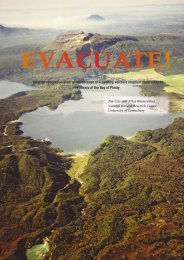Volcanoes - Ministry of Civil Defence and Emergency Management
Volcanoes - Ministry of Civil Defence and Emergency Management
Volcanoes - Ministry of Civil Defence and Emergency Management
You also want an ePaper? Increase the reach of your titles
YUMPU automatically turns print PDFs into web optimized ePapers that Google loves.
Dominating the central North Isl<strong>and</strong> l<strong>and</strong>scape, the stunning Mt. Ngauruhoe with Mt. Tongariro on the right. Photo: GNS Lloyd Homer.<br />
that we see today is only about 10,000 years old <strong>and</strong><br />
has rapidly built up since the last major collapse. The<br />
latest eruption where magma has reached the surface<br />
is thought to have occurred in 1755 AD, so the volcano<br />
is considered to be dormant. Eruptive products from<br />
Egmont are <strong>and</strong>esitic to dacitic in composition. They<br />
form domes <strong>and</strong> lava flows that, together with some<br />
pyroclastic material have built up the modern cone itself,<br />
together with comparable volumes <strong>of</strong> pumice, scoria<br />
<strong>and</strong> ash that have spread as thin pyroclastic fall <strong>and</strong> flow<br />
deposits beyond the cone.<br />
Tongariro/Ngauruhoe<br />
Tongariro is a large (100 km 3 ) cone volcano <strong>of</strong><br />
which the youngest cone, Ngauruhoe, is the main active<br />
centre. Tongariro, like Egmont, has been both built up by<br />
eruptions <strong>of</strong> lava flow <strong>and</strong> pyroclastic material as well as<br />
partially destroyed on occasions in the past. However, the<br />
main destructive force at Tongariro does not appear to<br />
have been cone collapse, so much as erosion by ice during<br />
glacial periods. The oldest lavas from Tongariro are at least<br />
340,000 years old, <strong>and</strong> occur in places that imply there was<br />
a substantial ‘Mt Tongariro’ at that time. The modern cone<br />
has grown since 275,000 years ago, with intervals <strong>of</strong> cone<br />
building occupying a few thous<strong>and</strong> to tens <strong>of</strong> thous<strong>and</strong>s <strong>of</strong><br />
years (Ngauruhoe is only 2,500 years old). These conebuilding<br />
periods are separated by times when either most<br />
activity was expressed as widespread pyroclastic deposits<br />
(which did not contribute much to cone building) or<br />
the volcano was much less active. In most eruptions the<br />
magma was <strong>and</strong>esite, but some minor amounts <strong>of</strong> dacite<br />
<strong>and</strong> basalt are also known here. The most prominent vent,<br />
Ngauruhoe, has been frequently active in recorded times,<br />
but has not erupted since 1975 <strong>and</strong> is now undergoing its<br />
longest break from activity in recorded history.<br />
Ruapehu<br />
Ruapehu is New Zeal<strong>and</strong>’s largest cone volcano<br />
<strong>and</strong>, like Tongariro <strong>and</strong> Egmont, has been built up<br />
<strong>and</strong> partially destroyed on several occasions during its<br />
history. The oldest dated lavas are ~230,000 years old,<br />
but there has probably been a volcano in the Ruapehu<br />
area for at least 0.8 million years. Destructive influences<br />
at Ruapehu include both cone collapse <strong>and</strong> glacial<br />
erosion, the latter continuing to the present day. Like<br />
Tongariro, Ruapehu has erupted mostly <strong>and</strong>esite, <strong>and</strong><br />
only minor amounts <strong>of</strong> basalt <strong>and</strong> dacite have been<br />
found. Ruapehu is unusual among the cone volcanoes in<br />
having a crater lake which, in historic times, has greatly<br />
modified eruptive behaviour such that even small<br />
eruptions are accompanied by potentially dangerous<br />
mudflows or lahars. With the exception <strong>of</strong> the 1945<br />
eruption, the lake has acted as a trap for magmatic heat<br />
<strong>and</strong> volatiles, so making it warm <strong>and</strong> highly acidic.<br />
Ejection <strong>of</strong> lake water leads to the formation <strong>of</strong> lahars,<br />
one <strong>of</strong> which in 1953 led to New Zeal<strong>and</strong>’s worst<br />
volcanic disaster at Tangiwai. The four largest eruptions<br />
have been in 1945, when a lava dome partly displaced<br />
the Crater Lake, 1969 <strong>and</strong> 1975, when large explosions<br />
through the lake generated destructive lahars, <strong>and</strong> in<br />
1995-1996 (see inset article).<br />
White Isl<strong>and</strong><br />
White Isl<strong>and</strong> is the 320 m high emergent tip <strong>of</strong> a<br />
17 km wide, 750 m high cone volcano largely submerged<br />
beneath the Bay <strong>of</strong> Plenty. It is unusual in being one <strong>of</strong><br />
the very few privately owned volcanoes in the world.<br />
White Isl<strong>and</strong> is currently New Zeal<strong>and</strong>’s most active<br />
volcano with three long cycles <strong>of</strong> eruption recorded<br />
between 1976 <strong>and</strong> 2000. Our knowledge <strong>of</strong> the earlier<br />
history <strong>of</strong> the isl<strong>and</strong> is severely limited by a lack <strong>of</strong> data<br />
on the age <strong>of</strong> prehistoric eruptions. This early history<br />
includes two major episodes <strong>of</strong> cone growth with both<br />
extrusion <strong>of</strong> lava flows <strong>and</strong> explosive eruptions. There are<br />
no recognisable products <strong>of</strong> primeval or historic activity<br />
from White Isl<strong>and</strong> preserved on the mainl<strong>and</strong>. Historic<br />
activity included a small collapse <strong>of</strong> the west wall <strong>of</strong> the<br />
7<br />
TEPHRA<br />
June 2004

















